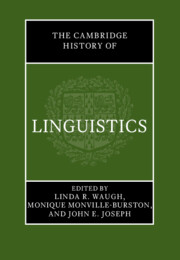Book contents
- The Cambridge History of Linguistics
- The Cambridge History of Linguistics
- Copyright page
- Dedication
- Contents
- Figures
- Tables
- Contributors
- Preface
- Acknowledgments
- Abbreviations, Acronyms, Special Symbols, and Other Conventions
- Introduction
- Part I Ancient, Classical, and Medieval Periods
- Part II Renaissance to Late Nineteenth Century
- Part III Late Nineteenth-through Twentieth-Century Linguistics
- Part IIIA Late Nineteenth Century through the 1950s: Synchrony, Autonomy, and Structuralism
- Part IIIB 1960–2000: Formalism, Cognitivism, Language Use and Function, Interdisciplinarity
- 17 Chomsky and the Turn to Syntax, Including Alternative Approaches to Syntax
- 18 Functionalist Dimensions of Grammatical and Discourse Analysis
- 19 Semantics and Pragmatics
- 20 Language and Philosophy, from Frege to the Present
- 21 Lexicology and Lexicography
- 22 Generative Phonology: its Origins, its Principles, and its Successors
- 23 Phonetics and Experimental Phonology, c. 1950–2000
- 24 Historical and Universal-Typological Linguistics
- 25 Language and Society
- 26 Language and Anthropology
- 27 Language and Psychology, 1950–Present: A Brief Overview
- 28 Semiotics
- 29 Applied Linguistics
- References
- Index
22 - Generative Phonology: its Origins, its Principles, and its Successors
from Part IIIB - 1960–2000: Formalism, Cognitivism, Language Use and Function, Interdisciplinarity
Published online by Cambridge University Press: 20 July 2023
- The Cambridge History of Linguistics
- The Cambridge History of Linguistics
- Copyright page
- Dedication
- Contents
- Figures
- Tables
- Contributors
- Preface
- Acknowledgments
- Abbreviations, Acronyms, Special Symbols, and Other Conventions
- Introduction
- Part I Ancient, Classical, and Medieval Periods
- Part II Renaissance to Late Nineteenth Century
- Part III Late Nineteenth-through Twentieth-Century Linguistics
- Part IIIA Late Nineteenth Century through the 1950s: Synchrony, Autonomy, and Structuralism
- Part IIIB 1960–2000: Formalism, Cognitivism, Language Use and Function, Interdisciplinarity
- 17 Chomsky and the Turn to Syntax, Including Alternative Approaches to Syntax
- 18 Functionalist Dimensions of Grammatical and Discourse Analysis
- 19 Semantics and Pragmatics
- 20 Language and Philosophy, from Frege to the Present
- 21 Lexicology and Lexicography
- 22 Generative Phonology: its Origins, its Principles, and its Successors
- 23 Phonetics and Experimental Phonology, c. 1950–2000
- 24 Historical and Universal-Typological Linguistics
- 25 Language and Society
- 26 Language and Anthropology
- 27 Language and Psychology, 1950–Present: A Brief Overview
- 28 Semiotics
- 29 Applied Linguistics
- References
- Index
Summary
This co-authored chapter traces the development of generative and other formal approaches to phonology from 1960-2000. After discussing empiricism, positivism, and logical positivism, Prague Circle functional phonology (Jakobson, Trubetzkoy 1939) and American phonology (Harris 1950s), it turns to Generative Phonology, launched by Chomsky and Halle (Sound Pattern of English, SPE 1968), with its algorithmic mentalism: explicit formulation; formal simplicity used to choose between analyses; derivational rules (from underlying to surface form); no phonemic ‘contrast’; ‘abstract’ (non-occurring) segments can ‘trigger’ a rule.
From the 1960s to the end of the century, there were serious criticisms of SPE and debates about a series of new approaches: ‘concrete’ Natural Generative and Natural Phonology; Lexical Phonology; and, with the integration of the syllable, Autosegmental and Metrical Phonology. The late 1980s and 1990s brought (rule) ‘conspiracies’ and ‘harmonic phonology,’ which ultimately led to Optimality Theory (OT), in which an algorithm selects a surface representation that satisfies a set of ranked (universal) constraints. In 2000+, OT was the most popular formal approach.
Other approaches studied the relationship of phonetics and phonology, linked phonology and psychological experimentation, variation in phonology, and so forth.
Keywords
- Type
- Chapter
- Information
- The Cambridge History of Linguistics , pp. 704 - 727Publisher: Cambridge University PressPrint publication year: 2023



